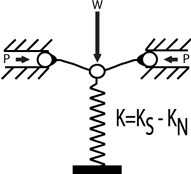The Minus K® vibration isolators use never before seen technology the prevents interring low frequencies vibration. An inflexible coil can uphold a weighty load using a negative stiffness mechanism (NSM) that stops vibration coming from movement in the vertical direction. The total vertical stiffness is maintained to a very small amount averting interfering with the fixed load-bearing properties of the coil.
A series of connected beam-columns that have vertical-movement isolation give horizontal-movement isolation. A beam-column copies the activity of a NSM and spring hybrid, and the horizontal stiffness of the beam like columns is lessened by the “beam-column” effect. This produces a dense passive isolating system with the power to stop low level frequencies in both the horizontal and vertical direction, in addition to high internal structural vibrations.
Minus K® Vibration Isolators
Three Minus K® devices can be put on top of one another, with a horizontal-motion device sandwiched in between a vertical-motion isolator underneath, and a tilt-motion isolator above.

Figure 1
Figure 2
Tilt-Motion Isolators
Negative-rigidness vibration mechanism diagram is illustrated in Figure 3 and also includes Figures 1 and 2 isolators. The tilt-motion isolator is assisted by a tilt pad. A vertical rigidness modification screw is used to alter the compression force on the negative-rigidness flexures and so altering the vertical rigidness. Different vertical weight loads can be accommodated for using a vertical load altering screw, which raises or lowers the bottom of the spring that supports isolator. This ensures that the flexures are kept from bending or becoming unstraight in the functioning position. This function can be made automatic in single-isolator mechanisms and needed to achieve automated leveling in isolator mechanisms that are made up of more than one.
Figure 3

This information has been sourced, reviewed and adapted from materials provided by Minus K Technology.
For more information on this source, please visit Minus K Technology.